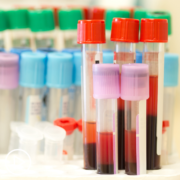What Is a FISH Test?
What is a FISH Test? from Patient Empowerment Network on Vimeo.
What is a FISH test for multiple myeloma patients? Watch as expert Donna Catamero explains how fluorescent in situ hybridization (FISH) testing is used, and myeloma patient and Empowerment Lead Lisa Hatfield shares her experience with FISH testing and her advice to other patients.
See More from START HERE Myeloma
Related Resources:

|

|

|
Transcript:
Donna Catamero:
So, FISH is a cytogenetic technique. So, what we do is, when we do the bone marrow, we send that off and we look at the genetics. Like I said, it’s a snapshot. And certain mutations will put patients in different risk stratifications, so we normally do this at the time of diagnosis and then with each relapse.
In a FISH test, a bone marrow biopsy is taken to map out the genetic material of a cell using fluorescent dyes. These dyes show specific parts of chromosomes and help locate genetic issues like 11;14 translocation, 17 deletion, and others that are important in determining multiple myeloma treatment. If you have not had a FISH test, make sure to ask your doctor if the test should be performed to aid in your diagnosis and treatment.
Lisa Hatfield:
The first time I heard FISH test I had no idea what my doctor was talking about. It was actually a nurse practitioner who works with my myeloma specialist who said, “Your FISH test came back, and you have two abnormalities. One of them is called translocation 11;14, standard risk. And one is called monosomy 13, which sometime in the past used to be considered a higher risk but apparently it’s not anymore.” She was trying to explain this to me. I had no idea what she meant what a FISH test was. As time went on and I started to study a little bit more, do a little bit more research on myeloma, I understand the significance and the importance of having a FISH test done for anyone who’s getting diagnosed at a local hospital or community cancer center. I encourage everyone to make sure they can have a FISH test done even if that means consulting with a myeloma specialist to ensure that they can find those cytogenetic abnormalities or to test for those. Because that will help guide your treatment and your prognosis going forward. You want to know what those cytogenetic abnormalities are. They’ll be tracking those over time. So a FISH test is kind of confusing. But without going into too much detail, it’s an interesting test that they can do. It’s very helpful if it’s done at diagnosis. Important to be done at diagnosis, so those genetic abnormalities can be tracked over time through further testing.






